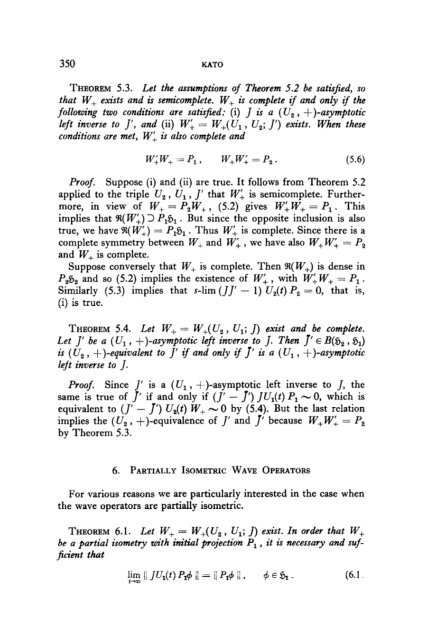On the Characters and the Plancherel Formula of Nilpotent Groups ...
On the Characters and the Plancherel Formula of Nilpotent Groups ...
On the Characters and the Plancherel Formula of Nilpotent Groups ...
You also want an ePaper? Increase the reach of your titles
YUMPU automatically turns print PDFs into web optimized ePapers that Google loves.
350 KATO<br />
THEOREM 5.3. Let <strong>the</strong> assumptions <strong>of</strong> Theorem 5.2 be satisjed, so<br />
that W+ exists <strong>and</strong> is semicomplete. W, is complete if <strong>and</strong> only ;f <strong>the</strong><br />
following two conditions are satis$ed: (i) J is a (U, , +)-asymptotic<br />
left inwerse to J’, <strong>and</strong> (ii) W; = W+( U, , US; J’) exists. When <strong>the</strong>se<br />
conditions are met, Wi is also complete <strong>and</strong><br />
w;w+ = PI, w+w; = Pz. (5.6)<br />
Pro<strong>of</strong>. Suppose (i) <strong>and</strong> (ii) are true. It follows from Theorem 5.2<br />
applied to <strong>the</strong> triple U, , U, , J’ that W; is semicomplete. Fur<strong>the</strong>r-<br />
more, in view <strong>of</strong> W+ = P,W+ , (5.2) gives W;W+ = PI. This<br />
implies that %( Wi) 1 PI.!& . But since <strong>the</strong> opposite inclusion is also<br />
true, we have %( W;) = PI& . Thus W; is complete. Since <strong>the</strong>re is a<br />
complete symmetry between W+ <strong>and</strong> W; , we have also W+ W; = Pz<br />
<strong>and</strong> W+ is complete.<br />
Suppose conversely that W+ is complete. Then %( W+) is dense in<br />
P&, <strong>and</strong> so (5.2) implies <strong>the</strong> existence <strong>of</strong> W; , with W; W+ = PI .<br />
Similarly (5.3) implies that s-lim (Jy - 1) Uz(t) Pz = 0, that is,<br />
(i) is true.<br />
THEOREM 5.4. Let W+ = W+( U, , UI; J) exist <strong>and</strong> be complete.<br />
Let J’ be a (U, , +)-asymptotic left inverse to J. Then J’ E B($& , &)<br />
is (U, , +)-equivalent to J’ if <strong>and</strong> only if J’ is a (U, , +)-asymptotic<br />
left inverse to J.<br />
Pro<strong>of</strong>. Since J’ is a (U, , +)-asymptotic left inverse to J, <strong>the</strong><br />
same is true <strong>of</strong> J’ if <strong>and</strong> only if (J’ - y) JUI(t) PI N 0, which is<br />
equivalent to (J’ - J’) U%(t) W+ N 0 by (5.4). But <strong>the</strong> last relation<br />
implies <strong>the</strong> (U, , +)-equivalence <strong>of</strong> J’ <strong>and</strong> J’ because W+W; = Pz<br />
by Theorem 5.3.<br />
6. PARTIALLY ISOMETRIC WAVE OPERATOW<br />
For various reasons we are particularly interested in <strong>the</strong> case when<br />
<strong>the</strong> wave operators are partially isometric.<br />
THEOREM 6.1. Let W+ = W+( U, , VI; J) exist. In orde~ that W+<br />
be a partial isometry with initial projection PI , it is necessary <strong>and</strong> suf-<br />
$cient that

















